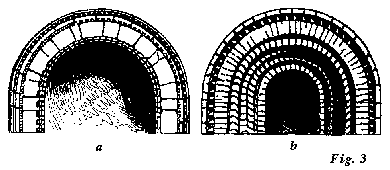III. MURANO 61
question doubtful. But one circumstance must be noted, bearing upon it closely.
In the woodcut below, Fig. 3, b is an archivolt of Murano, a one of St. Mark’s; the latter acknowledged by all historians and all investigators to be of the twelfth century.
All the twelfth century archivolts in Venice, without exception, are on the model of a, differing only in their decorations and sculpture. There is not one which resembles that of Murano.
But the deep mouldings of Murano are almost exactly similar to those of St. Michele of Pavia, and other Lombard
 |
churches built, some as early as the seventh, others in the eighth, ninth, and tenth centuries.1
On this ground it seems to me probable that the existing apse of Murano is part of the original earliest church, and that the inscribed fragments used in it have been brought from the mainland. The balustrade, however, may still be later than the rest; it will be examined, hereafter, more carefully.*
I have not space to give any farther account of the exterior of the building, though one half of what is remarkable in it remains untold. We must now see what is left of interest within the walls.
§ 34. All hope is taken away by our first glance; for it
* Its elevation is given to scale in fig. 4, Plate 13 below [p. 288].
1 [For St. Michele, see Vol. IX. p. 40 n.]
[Version 0.04: March 2008]